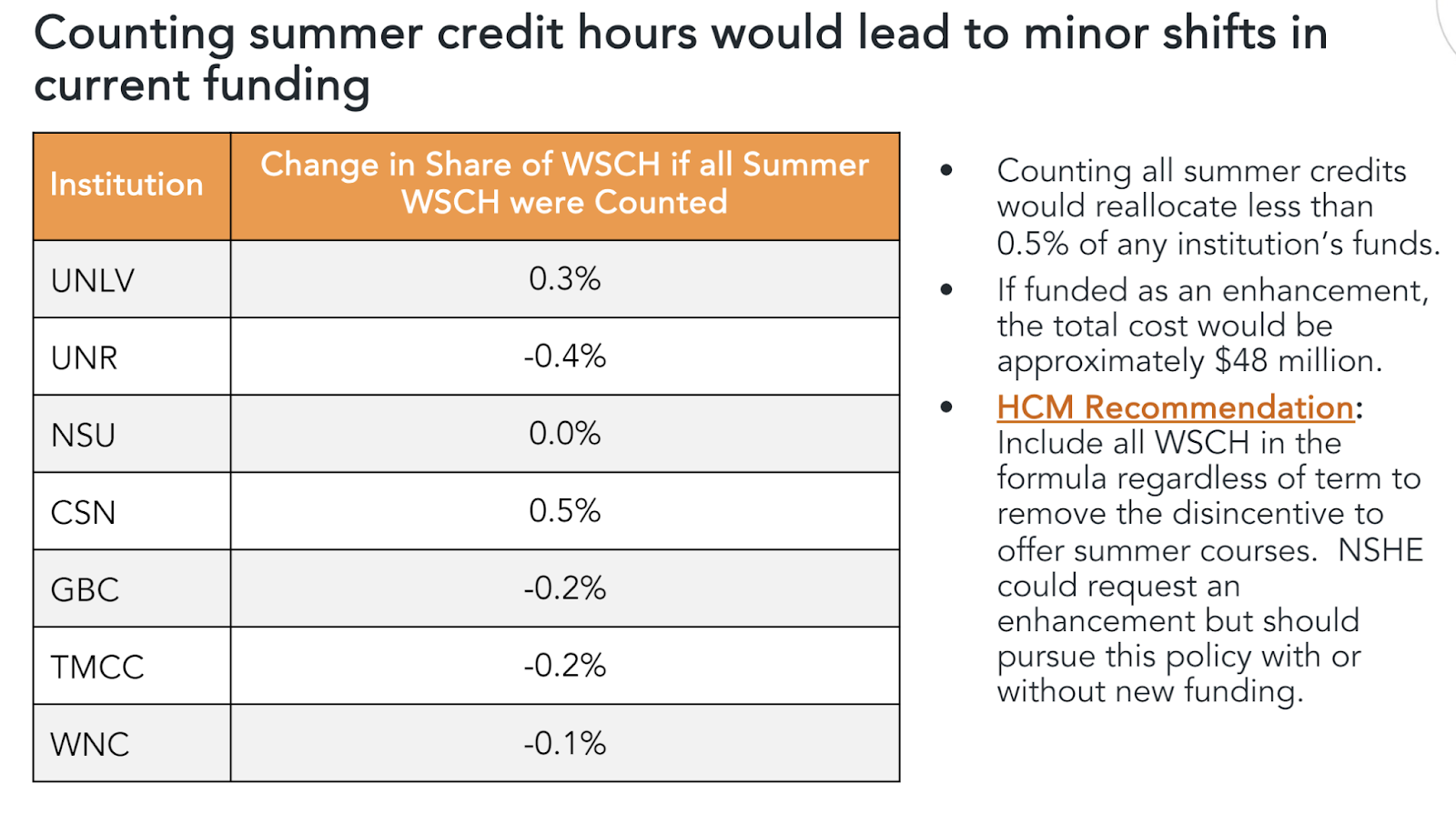Unintended Consequences of Including Summer Courses in the WSCH Formula
Part 3 in a series analyzing proposals being considered by the NSHE Committee on Higher Education Funding. These articles delve into various proposals the Committee will consider on May 30 and finalize on July 25. The NFA has issued a set of fundamental Principles for Funding Higher Education.
Summer Course Credits
Summer school courses have traditionally been funded by student fees, not the state. But over the years certain summer courses have been brought into the current funding-distribution formula based on resident Weighted Student Credit Hours (WSCHs). Nursing courses, science prerequisites for nursing, and teacher preparation courses were introduced as enhancements with appropriations for state-supported summer courses.
The CSN, GBC, NSU, and WNC presidents have proposed that summer courses be funded through the WSCH formula (Item #21 in Institutional Formula Recommendations). Their reasons include reducing the time to graduation by expanding summer course offerings and funding student support during the summer.
HCM Strategists, the consultants NSHE retained for the Committee, recommend adding summer courses to the WSCH formula with or without new funding. Although we support the general policy that the state fund all courses helping students earn their degree or certificate, bringing summer credits into the WSCH formula without additional funding would have dire consequences.
Budget Cuts for Rural Community Colleges
Non-state-funded summer credits range from 1% of WSCHs for GBC to 14% for NSU. As seen in Figure 1, HCM estimates that, with full funding, including all summer courses in the WSCH funding-distribution formula would cost an estimated $48 million. HCM describes “minor shifts” in current funding if summer credit hours are counted in the WSCH formula without additional funding.
Figure 1. Summary of including summer WSCH in the formula (HCM, p. 23).
However, HCM’s characterization of the budget effects as minor does not survive scrutiny. Table 1 examines the consequences for each institution’s funding.[1] A 5% to 6% decrease in funding at GBC and WNC is hardly a “minor shift.” Neither are funding cuts of 2% to 3% for NSU, UNR, and TMCC. NFA believes that any change must be fully funded.
Table 1. Summer WSCH without additional funding.
|
Institution
|
Percentage Change in Share of Total WSCH (Systemwide)
|
Change in Total WSCH Funding
|
Percentage Change in Total WSCH Funding
|
|
UNLV
|
0.77%
|
$3,873,296
|
2.0%
|
|
UNR
|
-0.69%
|
($3,504,870)
|
-2.7%
|
|
NSU
|
-0.11%
|
($557,363)
|
-1.9%
|
|
CSN
|
0.49%
|
$2,499,682
|
2.7%
|
|
GBC
|
-0.13%
|
($681,850)
|
-5.0%
|
|
TMCC
|
-0.15%
|
($768,229)
|
-2.3%
|
|
WNC
|
-0.17%
|
($860,667)
|
-5.8%
|
|
Totals
|
0.00%
|
$0
|
0.0%
|
Other Consequences
The discussion of summer course funding has not addressed how various institutions use summer school revenue. Although community colleges appear to collect the revenue centrally, UNLV and UNR rebate a portion to academic departments as an incentive to offer courses. Units and departments use this revenue for faculty development, conference travel for faculty and graduate students, research support, and emergencies. If summer courses are brought into state-supported operating budgets without funding, many of UNR’s and UNLV’s academic departments will face yet another budget crisis. Also, each university will risk support for research that contributes to R1 status.
In addition, faculty workloads will be required to support expanded summer course offerings. Given the difficulty of recruiting and retaining instructors, adding summer loads will be a big lift for some institutions and programs. Departments and units may have to compensate by proportionally reducing course loads for B-contract faculty during fall and spring semesters, which could lead to students finding reduced course offerings.
Conclusion
As previously stated by NFA, a new formula that merely redistributes available funding will be a failure. If summer WSCHs are added to the distribution formula, they must be fully funded as an added appropriation at HCM’s estimated cost of $48 million per year.
__________
[1] We cannot reproduce HCM’s percentages in Figure 1 using available public records, but the consequences using their percentages would be similar to those in Table 1. Our full calculations are available for review; corrections from authoritative sources are welcome.
***
We welcome feedback from faculty, especially department chairs, administrative faculty, and classified staff who manage state-supported budgets. Contacts: Kent Ervin (kent.ervin@nevadafacultyalliance.org), Doug Unger (doug.unger@nevadafacultyalliance.org), Jim New (jim.new@nevadafacultyalliance.org), and Staci Walters (staci.walters@nevadafacultyalliance.org.
Data are sourced from NSHE public records and reports. We welcome questions and corrections. Contact:kent.ervin@nevadafacultyalliance.org.
NFA Series on NSHE Funding Formula